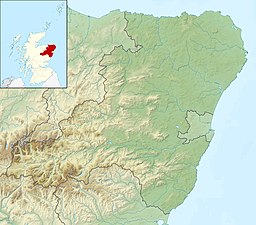| Loch Kinord | |
|---|---|
| Loch Kinnord,[1] Loch Ceander,[2] Loch Cannor[3] | |
 | |
| Location | Aberdeenshire, Scotland |
| Coordinates | 57°4′54″N 2°55′22″W / 57.08167°N 2.92278°W |
| Type | freshwater loch |
| Primary inflows | Vat Burn[4] |
| Primary outflows | River Dee |
| Basin countries | Scotland |
| Max. length | 1 mi (1.6 km)[2] |
| Max. width | 0.25 mi (0.40 km)[2] |
| Surface area | 76.9 ha (190 acres)[5] |
| Average depth | 5 ft (1.5 m)[2] |
| Max. depth | 12 ft (3.7 m)[2] |
| Water volume | 41,000,000 cu ft (1,200,000 m3)[2] |
| Shore length1 | 7.1 km (4.4 mi)[5] |
| Surface elevation | 167 m (548 ft)[5] |
| Islands | 7[5] |
| 1 Shore length is not a well-defined measure. | |
Loch Kinord is a small, freshwater loch at Muir of Dinnet, Aberdeenshire, Scotland just north of the River Dee and 5 mi (8 km) east of Ballater.[3] The loch is also known as Loch Ceander and Loch Cannor. It is approximately 1 mi (1.6 km) in length and was formed from a glacial kettle hole.[3][6] The loch sits within the Muir of Dinnet National Nature Reserve and is immediately south of Loch Davan.[6]
It contains several islets, as noted in a 19th-century book giving a brief description of the loch, and is forested with birch trees.[4]
- ^ "Prison Island, Loch Kinord". Canmore. Canmore. Retrieved 2 January 2015.
- ^ a b c d e f "Bathymetrical Survey of the Fresh-Water Lochs of Scotland, 1897–1909, Lochs of the Dee (Aberdeen) Basin". National Library of Scotland. Retrieved 2 January 2015.
- ^ a b c "Kinord, Loch: overview". Gazetteer of Scotland. Retrieved 2 January 2015.
- ^ a b "Kinord, Loch: history". Gazetteer of Scotland. Retrieved 2 January 2015.
- ^ a b c d "Loch Kinord". British lakes. British Lakes. Retrieved 2 January 2015.
- ^ a b "The story of Muir of Dinnet National Nature Reserve" (PDF). Scotland's National Nature Reserves. Retrieved 2 January 2015.
